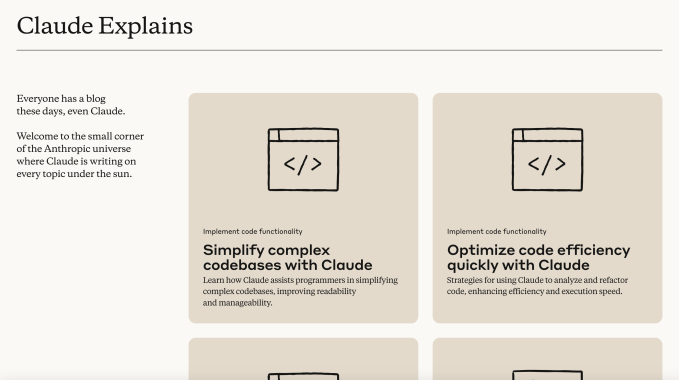Anthropic has given its AI a blog.
A week ago, Anthropic quietly launched Claude Explains, a new page on its website that’s generated mostly by the company’s AI model family, Claude. Populated by posts on technical topics related to various Claude use cases (e.g. “Simplify complex codebases with Claude”), the blog is intended to be a showcase of sorts for Claude’s writing abilities.
It’s not clear just how much of Claude’s raw writing is making its way into Claude Explains posts. According to a spokesperson, the blog is overseen by Anthropic’s “subject matter experts and editorial teams,” who “enhance” Claude’s drafts with “insights, practical examples, and […] contextual knowledge.”
“This isn’t just vanilla Claude output — the editorial process requires human expertise and goes through iterations,” the spokesperson said. “From a technical perspective, Claude Explains shows a collaborative approach where Claude [creates] educational content, and our team reviews, refines, and enhances it.”
None of this is obvious from Claude Explains’ homepage, which bears the description, “Welcome to the small corner of the Anthropic universe where Claude is writing on every topic under the sun.” One might be easily misled into thinking that Claude is responsible for the blog’s copy end-to-end.
Anthropic says it sees Claude Explains as a “demonstration of how human expertise and AI capabilities can work together,” starting with educational resources.
“Claude Explains is an early example of how teams can use AI to augment their work and provide greater value to their users,” the spokesperson said. “Rather than replacing human expertise, we’re showing how AI can amplify what subject matter experts can accomplish […] We plan to cover topics ranging from creative writing to data analysis to business strategy.”
Anthropic’s experiment with AI-generated copy, which comes just a few months after rival OpenAI said it had developed a model tailored for creative writing, is far from the first to be articulated. Meta’s Mark Zuckerberg has said he wants to develop an end-to-end AI ad tool, and OpenAI CEO Sam Altman recently predicted that AI could someday handle “95% of what marketers use agencies, strategists, and creative professionals for today.”
Elsewhere, publishers have piloted AI newswriting tools in a bid to boost productivity and, in some cases, reduce hiring needs. Gannett has been especially aggressive, rolling out AI-generated sports recaps and summaries beneath headlines. Bloomberg added AI-generated summaries to the tops of articles in April. And Business Insider, which laid off 21% of its staff last week, has pushed for writers to turn to assistive AI tools.
Story Continues

